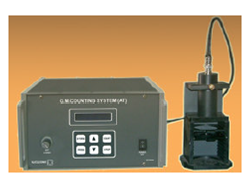Scintillation Detector:
These detectors are based on the interaction of nuclear radiation (especially γ) with solids (phosphor materials) where electronically excited atoms are produced, which in turn can emit light quanta. The number of light quanta emitted is proportional to the energy of the radiation absorbed and hence these radiation detectors permit energy discrimination. Typical materials used as phosphor or scintillator materials such as thallium doped NaI (Tl) crystals are particularly efficient for gamma ray detection because they contain high-Z material such as iodine and silver which have relatively higher density. Generally, a scintillation detector consists of a phosphor placed in close contact with a photomultiplier tube as shown in Figure. Schematic diagram of various components of the measuring system consisting of a detector and associated electronic system are also shown. The flashes of light emitted from the phosphor are converted into photoelectrons in the photosensitive cathode and then enter the photomultiplier tube, generating a large current pulse from each scintillation event.

A typical GM counter system
The current pulse is then converted into a voltage pulse, which is amplified and analyzed. The amplitude of this pulse is the pulse height which is proportional to the energy of γ radiation originally deposited in the phosphor.